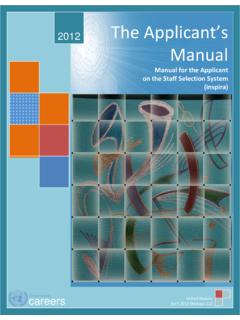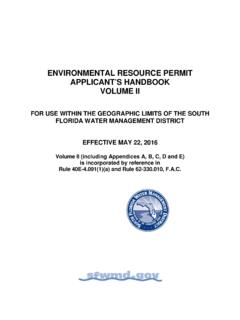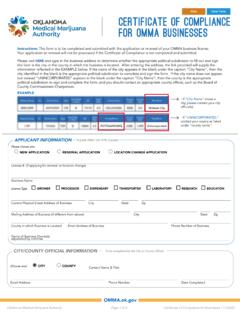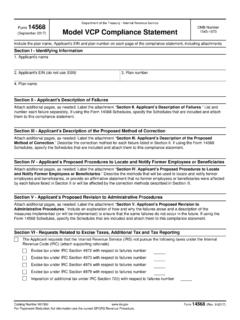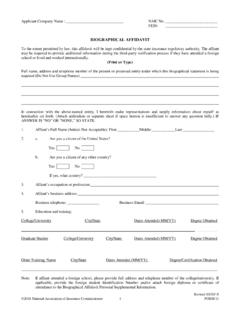Transcription of FEDERAL HR COMPLIANCE CHART
1 FEDERAL HR COMPLIANCE CHART COMPLIANCE AffectsEmployers of All Sizes1 ThinkHR grants the reader non-exclusive, non-transferable, and limited permission to use this document. The reader may not sell or otherwise use this document without express permission. ThinkHR provides this document to our clients for general information and encourages users to review the applicable FEDERAL and state insurance and labor laws and/or seek guidance from legal counsel before establishing any company policy or procedures relating to bene ts and their clients who are registered to receive ThinkHR services may contact the HR Hotline at 877-225-1101 with following CHART provides a basic summary of some of the most common FEDERAL laws affecting employers. Many of the coverage requirements are based upon employer size; however, in some cases, coverage requirements may be based upon other factors ( , size of the contract).
2 More information for each statute is available by clicking on the links. Employers should also check state statutes to ensure COMPLIANCE in the jurisdiction(s) where the company operates. ThinkHR 2013 - Discrimination in Employment Act (ADEA)(1)(29 621) Protects people who are 40 or older from discrimination because of age. The law also makes it illegal to retaliate against a person because the person complained about discrimination, led a charge of discrimination, or participated in an employment discrimination investigation or employers with 20 or more Requirements. Covered by Title VII posting requirement (see Title VII section below). Notice Requirements. None. Americans with Disabilities Act (ADA)(2)(42 12101) Makes it illegal to discriminate against a quali ed person with a disability in the private sector and in state and local governments.
3 The law also makes it illegal to retaliate against a person because the person complained about discrimination, led a charge of discrimination, or participated in an employment discrimination investigation or lawsuit. The law also requires that employers reasonably accommodate the known physical or mental limitations of an otherwise quali ed individual with a disability who is an applicant or employee, unless doing so would impose an undue hardship on the operation of the employer's employers with 15 or more Requirements. Covered by Title VII posting requirements (below).Notice Requirements. StatuteWhat It DoesPosting and Notice Requirements(1) , (2) COMPLIANCE AffectsEmployers of All Sizes2 ThinkHR 2013 - VII of the Civil Rights Act of 1964 Equal Employment Opportunities(3) (42 2000e et seq.) Makes it illegal to discriminate against someone on the basis of race, color, religion, national origin, or sex.
4 The law also makes it illegal to retaliate against a person because the person complained about discrimination, led a charge of discrimination, or participated in an employment discrimination investigation or lawsuit. The law also requires that employers reasonably accommodate applicants' and employees' sincerely held religious practices, unless doing so would impose an undue hardship on the operation of the employer's employers with 15 or more Requirements. Covered employers must post one of two equal opportunity posters: either the EEOC poster(4), or the Department of Labor s Of ce of FEDERAL Contract COMPLIANCE Program s (OFCCP) Employment Opportunity is the Law Poster.(5) Both posters are accepted as valid by OFCCP and the EEOC. The notice must be posted prominently, where it can be readily seen by employees and applicants for employment, , personnel of ce, work-out facility, lunchroom, or company bulletin board.
5 There is no particular size Requirements. NoneCivil Rights Act of 1991(6)(42 1981 1996b)Amended Title VII and the ADA to permit jury trials and compensatory and punitive damage awards in intentional discrimination casesCovers employers with 15 or more Requirements. Covered by Title VII posting requirement (above). Notice Requirements. None. Title III of the Consumer Credit Protection Act (CPPA)(7)(15 16 71 et seq.) Places restrictions on wage to all employers and individuals who receive earnings for personal services (including wages, salaries, commissions, bonuses, and periodic payments from a pension or retirement program, but ordinarily does not include tips).Posting Requirements. NoneNotice Requirements. NoneConsolidated Omnibus Bene ts Reconciliation Act (COBRA)(8)(29 1161 et seq.)Requires most group health plans to provide a temporary continuation of group health coverage that otherwise might be employers with 20 or more Requirements.
6 NoneNotice Requirements. Group health plans must provide covered employees and their families with certain notices(9) explaining their COBRA rights. They must also have rules for how COBRA continuation coverage is offered, how quali ed bene ciaries may elect continuation coverage, and when it can be StatuteWhat It DoesPosting and Notice Requirements(3) , (4) , (5) , (6) ,(7) , (8) ,(9) #COBRAN oticeandElectionProceduresHR COMPLIANCE AffectsEmployers of All Sizes3 ThinkHR 2013 - Contract Work Hours and Safety Standards Act (CWHSSA)(10) (40 3701 et seq.)Requires contractors and subcontractors with covered contracts (over $100,000) to pay laborers and mechanics employed in the performance of the contract one and one-half times their basic rate of pay for all hours worked over 40 in a to FEDERAL service contracts and FEDERAL and federally assisted construction contracts over $100, Requirements.
7 A poster is required to be posted on all contracts to which CWHSSA applies. The notice to be posted depends on the type of FEDERAL procurement contract involved either the Notice to all Employees Working on FEDERAL or Federally Financed Construction Projects(11) for Davis-Bacon contracts or, for contracts to which the Service Contract Act (SCA) applies, the Employee Rights on Government Contracts(12) must be posted. The appropriate poster(s) must be posted at the site of the work in a prominent and accessible place where it may be easily seen by employees. There is no size requirement for these posters but they must be easily Requirements. NoneCopeland Anti-Kickback Act(13)(18 874 and 40 3145)Precludes a contractor or subcontractor from inducing an employee to give up any part of the compensation to which he or she is entitled under his or her contract of employment.
8 The Act and implementing regulations require a contractor and subcontractor to submit a weekly statement of the wages paid to each employee performing on covered work during the preceding payroll period and list payroll deductions that are permissible or require consent of the Secretary of Labor. The "Anti-Kickback" section of the Copeland Act applies to all contractors and subcontractors performing on any federally funded or assisted contracts for the construction, prosecution, completion, or repair of any public building or public work, except contracts for which the only FEDERAL assistance is a loan guarantee and on work performed on federally funded contracts in excess of $2,000 or federally assisted contracts in excess of $2,000 subject to FEDERAL wage standards. This provision applies even where no labor standards statute covers the Requirements. NoneNotice Requirements.
9 NoneFederal StatuteWhat It DoesPosting and Notice Requirements(10) , (11) , (12) ,(13) , HR COMPLIANCE AffectsEmployers of All Sizes4 ThinkHR 2013 - and Related Acts (DBRA)(14) (40 3141a)Requires that all contractors and subcontractors performing work on FEDERAL or District of Columbia construction contracts in excess of $2,000, or on federally assisted contracts, pay their laborers and mechanics not less than the prevailing wage rates and fringe bene to contractors and subcontractors performing on federally funded or assisted contracts in excess of $2,000 for the construction, alteration, or repair (including painting and decorating) of public buildings or public Requirements. Every employer performing work covered by the labor standards of the DBRA must post the WH-1321 Employee Rights Under the Davis-Bacon Act poster at the site of the work in a prominent and accessible place where it may be easily seen by employees.
10 There is no particular size requirement. The wage determination must be similarly Requirements. NoneDrug-Free Workplace Act of 1988(15)(41 8101 et seq.) Requires some FEDERAL contractors and all FEDERAL grantees to agree that they will provide drug-free workplaces as a precondition of receiving a contract or grant from a FEDERAL to each FEDERAL contract or grant on a case-by-case basis. You will need to determine coverage(16) for each FEDERAL contract or grant you have, or for which you are Requirements. Under the Drug-Free Workplace Act, government contractors or employers receiving FEDERAL grants must certify to the contracting agency that they will maintain a drug-free workplace. This can be done by:1. Publishing a statement(17):Notifying employees that the unlawful manufacture, distribution, possession, or use of a controlled substance is prohibited in the workplace,Specifying the action that will be taken for violations of this policy; and2.
